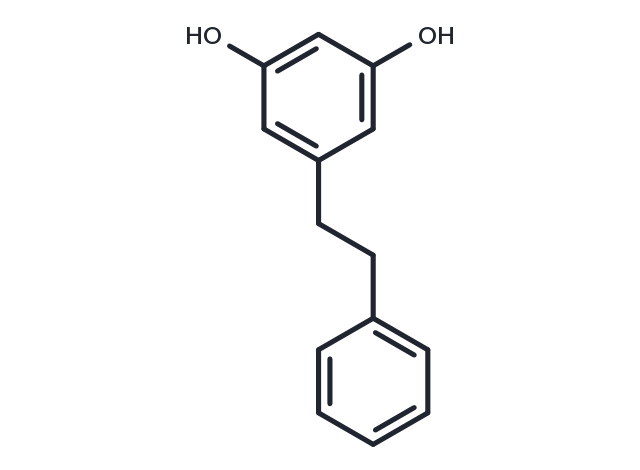Powder: -20°C for 3 years | In solvent: -80°C for 1 year


Dihydropinosylvinin is an phytoalexin, it shows antifungal activity against Cladosporium cladosporioides, Botryodiplodia theobromae, Aspergillus niger and Penicillium schlerotgenum, it also exhibits strong antibacterial activity against Bacillus cereus, Staphylococcus aureus, Pseudomonas aeruginosa and Escherichia coli.Dihydropinosylvin and batatasin IV can inhibit the germination of seeds of and root elongation in young seedlings of Sorghum bicolor.

| Pack Size | Availability | Price/USD | Quantity |
|---|---|---|---|
| 1 mg | In stock | $ 85.00 | |
| 2 mg | In stock | $ 126.00 | |
| 5 mg | In stock | $ 198.00 | |
| 10 mg | In stock | $ 298.00 | |
| 25 mg | In stock | $ 525.00 | |
| 50 mg | In stock | $ 758.00 | |
| 100 mg | In stock | $ 1,070.00 | |
| 500 mg | In stock | $ 2,130.00 | |
| 1 mL * 10 mM (in DMSO) | In stock | $ 189.00 |


| Description | Dihydropinosylvinin is an phytoalexin, it shows antifungal activity against Cladosporium cladosporioides, Botryodiplodia theobromae, Aspergillus niger and Penicillium schlerotgenum, it also exhibits strong antibacterial activity against Bacillus cereus, Staphylococcus aureus, Pseudomonas aeruginosa and Escherichia coli.Dihydropinosylvin and batatasin IV can inhibit the germination of seeds of and root elongation in young seedlings of Sorghum bicolor. |
| In vitro | Dihydropinosylvin, batatasin IV, demethylbatatasin IV and batatasin III were found in the water yam ( Dioscorea alata ) which had been inoculated with Botryodiplodia theobromae or treated with mercuric chloride. Following induction, transient increases were observed in the first three compounds and this was preceded by a transient increase in the activity of phenylalanine ammonia lyase but not tyrosine ammonia lyase activity. CONCLUSIONS: In mercuric chloride treated tubers an increase in polyphenol oxidase was also observed. The dormancy inducing compounds Dihydropinosylvin and batatasin IV were also found to inhibit the germination of seeds of and root elongation in young seedlings of Sorghum bicolor . By comparison, demethylbatatasin IV was not inhibitory. |
| Source |
| Molecular Weight | 214.26 |
| Formula | C14H14O2 |
| CAS No. | 14531-52-3 |
Powder: -20°C for 3 years | In solvent: -80°C for 1 year
DMSO: < 2.14 mg (10 mM, insoluble or slightly soluble)
You can also refer to dose conversion for different animals. More
bottom
Please see Inhibitor Handling Instructions for more frequently ask questions. Topics include: how to prepare stock solutions, how to store products, and cautions on cell-based assays & animal experiments, etc.
Dihydropinosylvin 14531-52-3 Microbiology/Virology Anti-infection inhibitor inhibit
